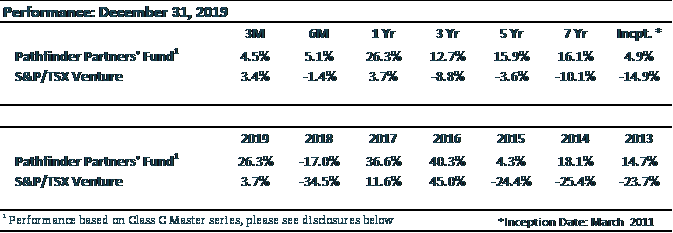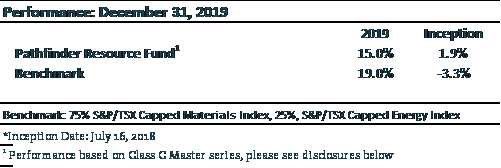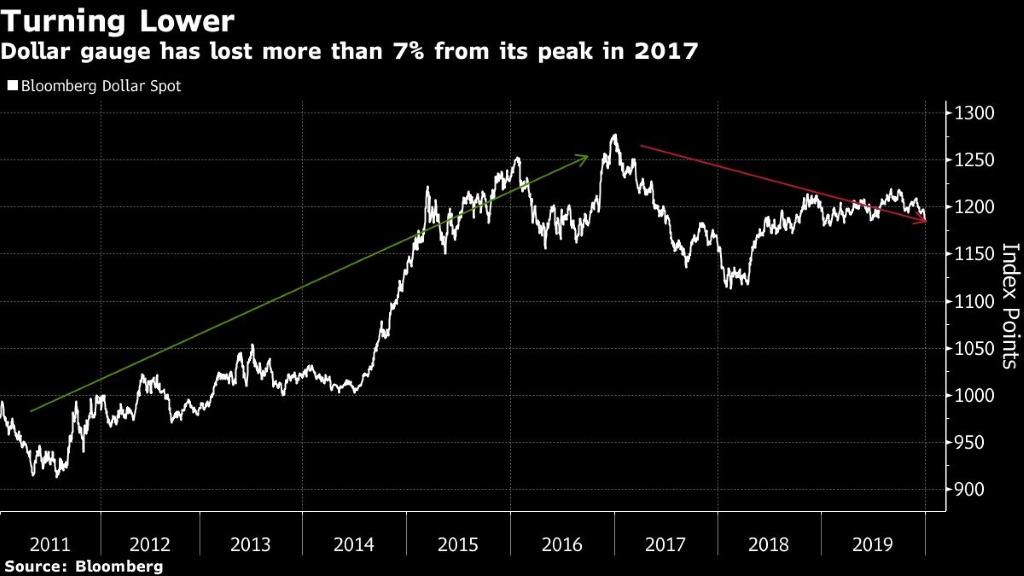Pathfinder Small Cap Quarterly Report
DECEMBER 31, 2019
The Pathfinder Small Cap mandates invest in high-torque, early-stage companies that have the potential to generate superior returns.
Pathfinder Partners’ Fund
The Partners’ Fund delivered a net return of 26.3% in 2019. This compares to the TSX Venture Exchange which returned 3.7%. Our annualized 7-year return is 16.1% compared to the TSX Venture Exchange’s return of -10.1% per year over the same period. The table below provides a performance summary:

During the year, our largest contributor was Xebec Adsorption Inc (TSXv:XBC) which added 13.2% to gross returns for the year. Other positive contributors include Cardiol Therapeutics Inc (TSX:CRDL), Acasti Pharmacueticals Inc (TSXv:ACST), and AnalytixInsight Inc (TSXv:ALY) which added 4.0%, 3.1%, and 2.7% to gross returns respectively. Our main detractor was Spring Bank Pharmaceuticals Inc (NASDAQ:SBPH) which decreased gross returns by 2.1%.
During 2019, most of the major stock indices in North America performed strongly. Much of this return came from multiple expansion rather than earnings growth. As a general rule, rate of return is inversely related to price paid; as multiples rise, expected long-term rates of return decline. Yet even though the large cap stock market appears extended by some measures, there continue to be low valuations and a scarcity of capital in small-caps. Due to institutional constraints (restricted ownership of small companies in investment funds), our investment universe is often overlooked, creating mispriced opportunities and an inefficient marketplace. These factors combine to create a compelling investment opportunity that is uncorrelated to the broader stock market. We believe an allocation to a well managed small-cap fund can help a portfolio generate superior returns.
Clean Energy & Sustainability has been a core theme of the Partners’ Fund since its inception and our investments in this space have added significantly to returns for unitholders. The global climate movement and green energy revolution continued to accelerate throughout the year. We have adopted a “Picks-and-Shovels” strategy where the companies we invest in provide technology, parts and services to rapidly growing sectors in the green economy. Rather than invest in a manufacturer (race to the bottom) or developer (commoditized business model), we invest in companies that are leveraged to growth in the sector but with a better economic profile, in our opinion.
For example, in the solar space, cell production has increased exponentially in the last decade. The increase was driven by efficiency gains in technology, cost reduction in manufacturing, and government incentives. Despite this enormous growth, cell manufacturers have performed poorly as low-cost cells from China have hurt their pricing power. Installers and developers have also performed poorly; the cost to install solar has declined so quickly that some projects became obsolete by the time they had completed construction. We have an investment in Aurora Solar Technologies Inc (TSXv:ACU) which has developed technology to improve yields and reduce costs for manufacturers. As manufacturers buy Aurora’s product, other manufacturers are forced to as well in order to compete. As solar continues to grow, so does the addressable market. Aurora Solar had a highly successful 2019, announcing a purchase order from the largest solar cell manufacturer in the world.
Other clean tech investments we have made include our top performing stock, Xebec Adsorption Inc (TSXv:XBC) and Exro Technologies Ltd (CSE:XRO). Xebec is a world leader in the technology to convert biogas to renewable natural gas. Renewable natural gas is a carbon neutral fuel that is produced from organic waste from places like farms, landfills, and water treatment plants. Exro has developed a platform technology that enables electric motors to run more efficiently and generate higher torque in certain applications. They had a breakout 2019 with a series of firsts, a production purchase order, licensing agreement, and delivery of a working prototype with their technology being fully integrated.
It is important to highlight that these investments aren’t being made on an ideological basis, but because they make good business sense. In the last few months, there has been commentary about ESG (Environmental, Social, Governance) and fossil fuel investments. The former governor of the Bank of Canada and outgoing governor of the Bank of England, Mark Carney, recently called on companies and financial institutions to justify their investment in fossil fuels. Despite his strong credentials as an environmentalist, these comments were made based on an economic argument. His view is that fossil fuel investments need to be justified due to the risk of assets becoming stranded as the economy produces more clean energy.
Blackrock, the largest asset manager in the world, recently announced that they are overhauling their investment strategy due to climate change and are prioritizing sustainability in their investment process. Larry Fink (Blackrock’s CEO) believes that climate risk is investment risk and that sustainability- and climate-integrated portfolios can provide better risk-adjusted returns to investors. Similar to these well known figures in the industry, we are investing in sustainability for the purpose of generating better returns for unitholders.
Pathfinder Resource Fund
During the year, the Resource fund rose 15.0%. This compares to the benchmark return of 19.0%. Since inception (July 16, 2018), the Resource Fund has returned 1.9% annualized versus the benchmark which declined by 3.3% per year. The benchmark consists of 75% of the daily return of the S&P/TSX Capped Materials Index and 25% of the daily return of the S&P/TSX Capped Energy Index.

During the year, Calibre Mining Corp (TSX:CXB) and Equinox Gold Corp (TSX:EQX) were our largest positive contributors, adding 6.2% and 2.8% to gross returns for the year respectively. Our largest negative contributors were Diamcor Mining Inc (TSXv:DMI) and Firefox Gold Corp (TSXv:FFOX) which decreased gross returns by 2.3% and 1.5%.
Equinox outperformed this quarter averaging a 41% return and contributing significantly to the performance of the fund. As one of our core holdings, EQX’s success was rooted in several key catalysts. Earlier in the year, a $130 million-dollar investment by Mubadala Investment Company allowed EQX to strengthen their balance sheet and focus on achieving commercial production at its Aurizona Gold Mine while commencing construction of the Castle Mountain Gold Mine. Equinox Gold also recently announced a merger of equals with Leagold Mining (LMC-TSX) creating a top gold producing company focused entirely in the Americas (lower risk profile) with a gold production guidance of 700,000 oz for 2020. This is a transformational merger in the sense of scale (production potential for 1 million ounces), improved liquidity, and access to the larger indices.
In the previous quarterlies we reiterated our supply driven thesis indicating the potential for a commodities bull market on the horizon. After trading relatively flat throughout the quarter, the gold price had an upside breakout throughout 2019 and in late December which has continued into the New Year. We believe the ingredients are in place for additional gains as investors recognize the opportunity arising in the commodity sector. In addition, the ongoing geopolitical instability has investors once again warming up to the precious metal.
Another factor responsible for the recent surge in gold price is the weakness of the dollar toward the end of the year and continued down trend since 2017 (figure 1). The Bloomberg Dollar Spot Index, which tracks the U.S. currency against 10 global peers, slid 2% in December, the biggest monthly decline in almost two years. The US dollar saw strong safe-haven support throughout most of the 2019 until Washington and Beijing announced progress towards a trade truce in October which was later formalized as President Donald Trump signed off on a phase-one trade deal with China. The trade deal not only benefits precious metals but also has the potential to stimulate demand for base metals namely copper which is at 6-months highs.

In terms of our earlier stage holdings we provide highlights on GR Silver Mining Ltd (TSXv:GRSL) formerly known as Goldplay Exploration and Tinka Resources Limited (TSXv:TK). One of the most effective companies in the exploration sector at deploying capital in our opinion has been GR Silver Mining. Management has successfully consolidated a district scale land package through two key acquisitions propelling them from an exploration company to near-term development company, highlighted by the name change. The significance of this transaction relates to the resulting infrastructural synergies between all the projects and the inexpensive cost of the acquisitions. GPLY essentially gave up 19.9% ownership equivalent to $3 million for a property listed at $15 million. However, the intrinsic value of the acquisition is much more due to the extensive exploration database (provides a wealth of technical data), fully permitted site (past producer with exploration upside), and infrastructure including a 60 km power line. We are optimistic on GR Silver’s prospects for 2020.
Tinka has lagged this year following the release of a Preliminary Economic Assessment on their project. The reason for the decline in our opinion is the need for Tinka to raise additional capital to advance their project. They have recently turned things around after securing an above market financing (83% premium) from Buenaventura; a precious and base metals mining company with operations in Peru. This endorsement by Buenaventura helps put TK back on track and supports our thesis that TK offers exposure to a junior with one of largest undeveloped zinc projects, positioning it as a potential acquisition target for a local operator. Tinka has consolidated nicely forming a strong base in the fourth quarter supported the new capital injection and is poised to capitalize on its exploration upside potential and PEA optimization.
National Instrument 31-103 requires registered firms to disclose information that a reasonable investor would expect to know, including any material conflicts with the firm or its representatives. Doug Johnson and/or Pathfinder Asset Management Limited are an insider of companies periodically mentioned in this report. Please visit www.paml.ca for disclosures.
* All returns are time weighted and net of investment management fees. Returns from the Pathfinder Partners’ Fund are presented based on the Class C Master series except prior to its inception in July 2011 when the Class A Master series was used. Inception returns include the 10 months from inception in March 2011. Returns greater than one year are annualized. Returns from the Pathfinder Resource Fund are presented based on the Class C Master series since its inception in July 16, 2018. The S&P/TSX Venture Composite Index (C$), the S&P/TSX Venture Composite Index, the S&P/TSX Capped Materials Index and the S&P/TSX Capped Energy Index provide general information and should not be interpreted as a benchmark for your own portfolio return. Further details of the Partners’ Fund are available on request.
Pathfinder Asset Management Limited (PAML) and its affiliates may collectively beneficially own in excess of 10% of one or more classes of the issued and outstanding equity securities mentioned in this newsletter. This publication is intended only to convey information. It is not to be construed as an investment guide or as an offer or solicitation of an offer to buy or sell any of the securities mentioned in it. The author is an employee of PAML, but the data selection, analysis and views expressed herein are solely those of the author and not those of PAML. The author has taken all usual and reasonable precautions to determine that the information contained in this publication has been obtained from sources believed to be reliable and that the procedures used to summarize and analyze such information are based on approved practices and principles in the investment industry. However, the market forces underlying investment value are subject to sudden and dramatic changes and data availability varies from one moment to the next. Consequently, neither the author nor PAML can make any warranty as to the accuracy or completeness of information, analysis or views contained in this publication or their usefulness or suitability in any particular circumstance. You should not undertake any investment or portfolio assessment or other transaction on the basis of this publication, but should first consult your portfolio manager, who can assess all relevant particulars of any proposed investment or transaction. PAML and the author accept no liability of any kind whatsoever or any damages or losses incurred by you as a result of reliance upon or use of this publication.